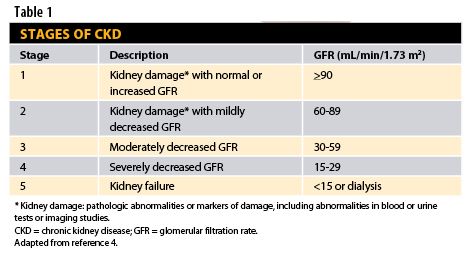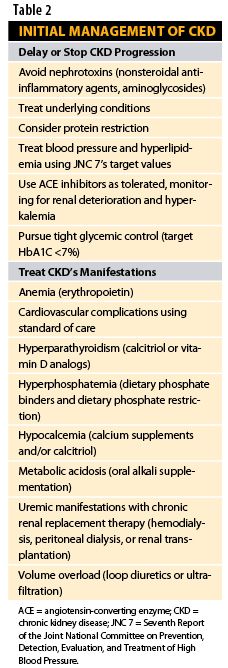Publication
Article
Pharmacy Times
Chronic Kidney Disease: Pharmacist Intervention Can Improve Quality of Life
Author(s):
Pharmacists can help slow the progression toward dialysis in patients living with chronic kidney disease.
Pharmacists can help slow the progression toward dialysis in patients living with chronic kidney disease.
In the healthy individual, two 4-oz excretory, biosynthetic, and metabolic organs—the kidneys—process about 50 gallons of blood daily, removing waste products and excess water. They are essential for erythropoietin synthesis, which stimulates red blood cell production. They metabolize 25-hydroxy-vitamin D to active 1,25-dihydroxy-vitamin D (calcitriol); this regulates calcium absorption and bone formation. In addition, their effect on rennin regulates blood volume and blood pressure. Should both kidneys fail, dialysis can replace some of their excretory functions, but the biosynthetic and metabolic activities are irreplaceable.
Chronic Kidney Disease and Risk Factors
In the United States, the prevalence of chronic kidney disease (CKD; Stages 1—5) is 16.8%.1 African American, Native American, Hispanic, Asian, and Pacific Islander populations are at higher risk for CKD than Caucasians. In these populations, diabetes and hypertension are the usual causes.2,3 Patients with a family history of diabetes, hypertension, or CKD are also at risk.
CKD is usually silent until its late stages, and without aggressive screening, it may escape detection until immediately before symptomatic kidney failure develops. Unimpeded, CKD’s terminal complication—end-stage renal disease (ESRD)—ends any opportunity to prevent kidney function decline or improve quality of life. Diabetes and hypertension are often comorbid.
In 2002, the National Kidney Foundation (NKF) Kidney Disease Outcomes Quality Initiative (KDOQI) Work Group developed the first staging system to define CKD according to the presence or absence of kidney damage and level of kidney function (Table 14). According to this classification, individuals with glomerular filtration rates (GFRs) less than 60 mL/min/1.73 m2 (the point at which more than 50% of an adult’s normal kidney function has been lost) for more than 3 months have CKD. Additionally, all individuals with kidney damage are classified as having CKD regardless of GFR. At Stage 5, dialysis or a kidney transplant is needed.2

An estimated 26 million patients have CKD, with most going undiagnosed.5 CKD experts consider the disease an epidemic, estimating that at least 20 million additional patients are at risk for CKD.2,3 The US Renal Data System estimates that by 2020, more than 700,000 Americans will have ESRD, with more than 500,000 requiring dialysis and more than 250,000 receiving a transplant.6
Guidelines for Treatment
The NKF created its KDOQI to provide comprehensive diagnosis and management guidelines for CKD. Why? Many CKD patients die from comorbidities before ESRD develops.6 In addition, CKD is among the most costly of health care challenges. Should dialysis be necessary, annual medical costs increase to $70,000. Transplant is more costly, with average medical costs of about $102,000 in the transplant year.6,7

Identifying CKD patients early and preventing progression to ESRD may improve quality of life and save health care dollars.8 Aggressive screening is needed. Once patients are identified, several interventions, described in Table 2, are crucial. Managing comorbid disease states and maintaining kidney function become twin priorities for CKD patients and their health care teams.
Patients with comorbid diabetes and CKD often have progressing hypertension. They may have difficulty maintaining tight blood pressure and glucose control together. If this is the case, having patients work on tight blood pressure control is more likely to reduce risk of stroke, any diabetic end point, diabetes mellitus death, or microvascular complications. 9 Angiotensin-converting enzymes (ACEs) and angiotensin receptor blockers (ARBs) have been proved to slow kidney and cardiovascular disease progression in diabetic populations specifically. Yet only 35% to 37% of patients who should be prescribed an ACE or an ARB (patients with diabetes, hypertension, or heart failure) receive them. Underutilization of ACEs and ARBs is an area for targeted improvement.10 Clinicians should continue to encourage patients to work on both diabetes and hypertension control.11
Anemia is a serious concern for CKD patients that is often managed with erythropoietin stimulating agents (ESAs). KDOQI goals acknowledge black box warnings on ESAs, emphasizing increased risk for death and serious cardiovascular reactions when administered to target a hemoglobin of more than 13 g/dL.12 These guidelines recommend hemoglobin targets of 11 to 12 g/dL in dialysis and nondialysis patients with CKD receiving ESA therapy.2
The Interdisciplinary Team
Establishing an interdisciplinary team to work with and involve the patient improves outcomes (Table 3). Involving, educating, and empowering patients at diagnosis can help them make informed decisions with their health care team. Early nephrologist involvement and use of evidencebased management principles increase the likelihood of optimal blood pressure control, decrease the risk of pulmonary edema, and improve the chances of having acceptable arteriovenous fistula access when dialysis becomes necessary.8
Medication review is critical for patients who have CKD. Patients need guidance in several areas because Stage 3 or 4 CKD patients usually have 6 to 8 medications in their drug regimens13; with ESRD, pharmacists can expect to see 10 to 12 different medications.14 Pharmacists need to ensure that renally cleared drugs are adjusted as the kidneys fail, and as new medications become necessary, patients will need help understanding their medications and their insurance, especially if they are on Medicare and working with a Part D formulary (these formularies often exclude some medications essential for CKD treatment). Careful therapeutic drug monitoring can prevent most interactions and adverse drug events. Some side effects are unavoidable, and the entire team needs to educate the patient about management techniques. Promoting adherence requires constant vigilance and encouragement.
Table 3. Role of the Multidisciplinary Team in CKD
Establish a Multidisciplinary Team Early
- Involve a renal dietitian and a pharmacist
- Refer to nephrology early
- Schedule general surgery for peritoneal catheter placement
- Schedule vascular surgery for permanent vascular access
Anticipate Chronic Renal Replacement Therapy
- Educate patients early and heavily about disease progression, potential dialysis modalities, renal transplantation, and the option to refuse or discontinue chronic dialysis
- Place permanent vascular access (arteriovenous fistula) at least 6 months before anticipated date of dialysis
- Arrange elective peritoneal dialysis catheter insertion
- Refer for renal transplantation early
- Restrict diet appropriately to CKD progression
- Restrict phosphate starting early in CKD
- Restrict protein as the patient progresses to ESRD to delay uremia onset
- Implement strategies to address or correct malnutrition
- Restrict potassium
- Restrict sodium and water as necessary to avoid volume overload
CKD = chronic kidney disease; ESRD = end-stage renal disease.
Conclusion
If expert projections are correct, CKD and ESRD will become an even greater burden on the health care system in the near future. Aggressive screening and early intervention are needed to prevent many victims from progressing to dialysis or kidney transplants. Pharmacists should urge high-risk patients to be screened. Screening is increasingly easy, and often free. Pharmacists should monitor public announcements for the NKF’s Kidney Early Evaluation Program (www.kidney. org/news/keep/index.cfm), a free program staffed with volunteers that offers local testing. Referring patients for this simple 30-minute screening will certainly save lives.
Ms. Wick is a senior clinical research pharmacist at the National Cancer Institute, National Institutes of Health, Bethesda, Maryland. The views expressed are those of the author and not necissarily those of any government agency.
References
1. American Heart Association. Heart disease & stroke statistics 2010 update at-a-glance. www.americanheart.org/downloadable/heart/1265665152970DS-3241%20HeartStrokeUpdate_2010.pdf. Accessed January 15, 2011.
2. National Kidney Foundation. K/DOQI Clinical practice guidelines for chronic kidney disease: evaluation, classification, and stratification. www.googlesyndicatedsearch.com/u/kidney?q=Clinical Practice Guidelines&sa.x=0&sa.y=0&sa=Go. Accessed August 25, 2007.
3. Coresh J, Astor BC, Greene T, Eknoyan G, Levey AS. Prevalence of chronic kidney disease and decreased kidney function in the adult US population: Third National Health and Nutrition Examination Survey. Am J Kidney Dis. 2003;41:1-12.
4. Clinical Practice Guidelines for CKD. Am J Kidney Dis 2002. [Citation.] www.kidney.org/professionals/kdoqi/guidelines_bp/executive_summary.htm#table2.
Accessed September 19, 2007.
5. Coresh J, Selvin E, Stevens LA, et al. Prevalence of chronic kidney disease in the United States. JAMA 2007;298:2038-2047.
6. The United States Renal Data System. The United States Renal Data System Annual Data Report 2007. www.usrds.org/adr.htm. Accessed September 25, 2007.
7. St. Peter WL, Khan SS, Ebben JP, Pereira BJG, Collins AJ. Chronic kidney disease: the distribution of health care dollars. Kidney Int. 2004;66:313-321.
8. Go AS, Chertow GM, Fan D, McCulloch CE, Hsu CY. Chronic kidney disease and the risks of death, cardiovascular events, and hospitalization. N Engl J Med. 2004;351:1296-1305.
9. Bakris GL, Williams M, Dworkin L, et al. Preserving renal function in adults with hypertension and diabetes: a consensus approach. National Kidney Foundation Hypertension and Diabetes Executive Committees Working Group. Am J Kidney Dis. 2000;36:646-661.
10. Imperatore G, Cadwell BL, Geiss L, et al. Thirty-year trends in cardiovascular risk factor levels among US adults with diabetes: National Health and Nutrition Examination Surveys, 1971-2000. Am J Epidemiol. 2004;160:531-539.
11. Sarnak MJ, Levey AS. Epidemiology of cardiac disease in dialysis patients. Semin Dial. 1999;12:69-76.
12. Kapur A, Malik IS, Bagger JP, et al. The Coronary Artery Revascularisation in Diabetes (CARDia) trial: background, aims, and design. Am Heart J. 2005;149:13-19.
13. Bailie GR, Eisele G, Liu L, et al. Patterns of medication use in the RRI-CKD study: focus on medications with cardiovascular effects. Nephrol Dial Transplant. 2005;20:1110-1115.
14. Manley HJ, Garvin CG, Drayer DK, et al. Medication prescribing patterns in ambulatory hemodialysis patients: comparisons of USRDS to a large non-for-profit dialysis provider. Nephrol Dial Transplant.2004;19:1842-1848.







